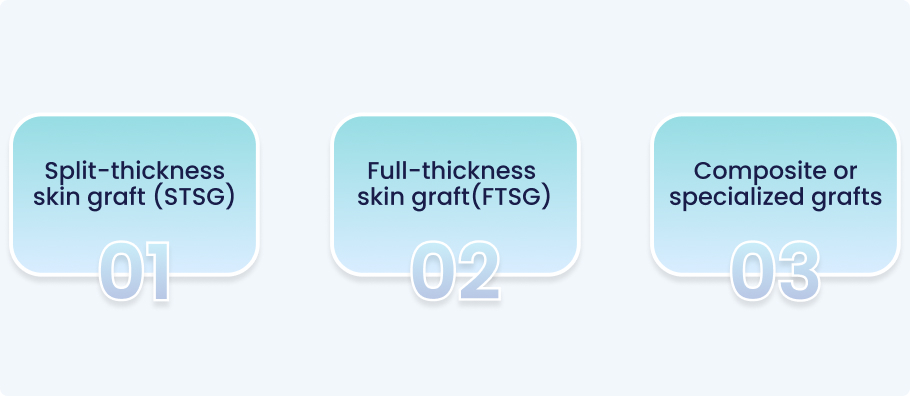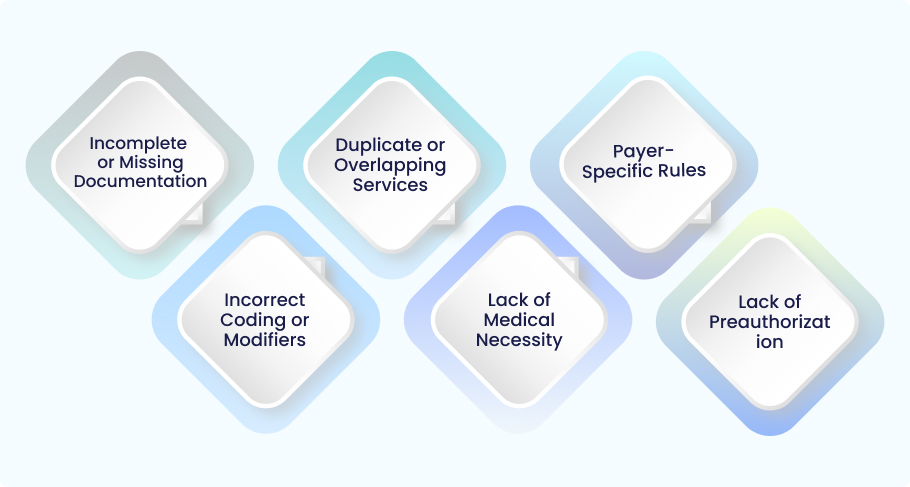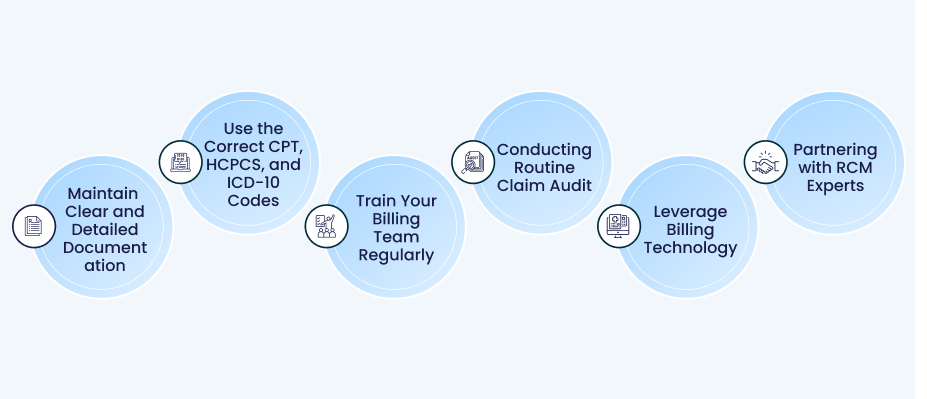Skin grafting plays a vital role in restoring damaged skin from burns, trauma, infections, or surgical procedures. While the clinical process is complex, accurate billing, coding, and
reimbursement management can be equally challenging.
To prevent claim denials and ensure optimal reimbursement, providers must master CPT and HCPCS coding, maintain detailed documentation, and follow payer-specific guidelines.
This guide explains every aspect of skin grafting billing—from procedure coding and documentation to reimbursement calculation—helping you improve claim accuracy, avoid costly denials, and maintain a healthy revenue cycle.
Understanding Skin Grafting Procedures and Their Billing Impact
When a wound cannot heal naturally, surgeons perform skin grafting—transferring healthy skin from a donor site to a damaged area. The choice of graft depends on the wound’s size, location, depth, and the patient’s condition.
Understanding each graft type helps ensure accurate coding and reimbursement.
Types of Skin Grafts Explained (STSG, FTSG, and Composite)
There are numerous types of skin grafts, each serving a special purpose and affecting how claims are coded and reimbursed:
Split-thickness skin graft (STSG):
Split-thickness skin graft (STSG) includes both the epidermis and dermis. Preferred for smaller, visible areas (e.g., face, hands) for superior cosmetic outcomes.
Full-thickness skin graft(FTSG):
The surgeon removes the epidermis and the entire dermis in this type of graft. Full-thickness skin grafts (FTSGs) are often used for smaller, more visible areas—such as the face—where superior aesthetic results are desired. Because they require more tissue, the donor site usually needs closure or suturing after the procedure.
Composite or specialized grafts:
Include additional tissue layers like fat or cartilage. Common in reconstructive procedures for complex areas such as the nose or ear.
Types of Skin Graft Sources (Autograft, Allograft, Xenograft)
Skin grafts are classified not only by thickness but also by their source:
- Auto graft: Skin taken from the patient’s body is the most common and least likely to be rejected.
- Allograft: Donor skin from another human, often used temporarily for burn wounds.
- Xenograft: Skin derived from animals, such as pigs, used as a temporary biological dressing.
Each graft type carries specific coding and reimbursement implications. For instance, autografts and allografts have different CPT or HCPCS codes, and documentation must clearly identify which type was used.
Comprehending these differences prior to coding or billing any skin grafting process is crucial. Correct classification guarantees correct reimbursement, accurate claims, and adherence to payer regulations.
CPT Coding for Skin Grafting Procedures: Key Codes and Guidelines
Accurate coding forms the foundation of successful skin grafting claims. CPT and HCPCS codes define each graft’s type, size, and location. Since payers calculate reimbursement based on these codes, even a minor error can lead to claim denials or underpayments.
CPT Codes for Skin Grafting
CPT codes for skin grafting are categorized by graft thickness (split or full) and size in square centimeters. The codes also vary depending on the graft’s anatomical location.
Here’s a quick breakdown:
Split-Thickness Skin Grafts (STSG)
Used for burns, ulcers, or large wounds.
| CPT Code | Graft Measurement |
| 15100 | Split-thickness autograft, up to 100 sq. cm, trunk, arms, or legs |
| 15101 | Each additional 100 sq. cm |
| 15120 | Full-thickness autograft, up to 20 sq. cm, trunk, arms, or legs |
| 15121 | Each additional 20 sq. cm |
Full-Thickness Skin Grafts (FTSG)
Used for smaller, more visible areas where better cosmetic results are needed.
| 15200 | Up to 20 sq. cm, trunk, arms, or legs |
| 15201 | Each additional 20 sq. cm |
| 15220 | Up to 20 sq. cm, face, scalp, eyelids, mouth, neck, ears, orbits, genitalia, hands, feet. |
| 15221 | Each additional 20 sq. cm |
The precise graft size should always be measured and recorded in square centimeters (cm2) rather than inches or approximations. The right CPT code is chosen for billing based on this measurement.
HCPCS Codes for Skin Graft Materials
Use HCPCS Level II codes when billing for biologic dressings, graft materials, or kits.
- Q4101–Q4199: Biologic skin substitutes (e.g., Apligraf, Dermagraft, Integra)
- A-codes: Supplies and grafting kits used during the procedure
Documenting the exact brand or product name helps justify the correct HCPCS code and supports payer reviews during audits.
Proper Use of Modifiers in Skin Grafting Claims
Modifiers clarify procedural details that affect reimbursement. For skin grafting:
| Modifiers | Use |
| Modifier 59 | Distinct procedural service at a different site or session |
| Modifier 51 | Multiple grafting procedures in the same session |
| Modifier 50 | Bilateral procedure |
Using the correct modifier prevents denials for duplicate or overlapping services.
Common Coding Mistakes to Avoid
These are some of the most frequent errors billers encounter in skin grafting claims:
- Submitting the wrong CPT code for the graft type or location
- Forgetting to include site documentation or graft size
- Misusing modifiers or missing them entirely
- Failing to bill separately for eligible materials or kits
Accurate coding ensures that claims reflect the true complexity and value of the procedure. It also protects providers from compliance risks and delayed payments.
Documentation Requirements for Skin Grafting Claims and Reimbursement
For skin grafting treatments to be coded, billed, and reimbursed, thorough documentation is necessary. Payers rely on comprehensive and unambiguous documentation to confirm treatment specifics, medical necessity, and appropriate grafting material use. Frequently, incomplete documentation leads to audits, postponed payments, or claim denials.
Documenting Medical Necessity:
Clearly state the reason for grafting (burn, trauma, ulcer, surgical defect). Include wound history and prior treatments.
Graft Type and Source:
Specify STSG, FTSG, or composite, and identify whether it’s an autograft, allograft, or xenograft.
Recording Donor and Recipient Sites:
Document exact locations and measurements (in cm²).
Including Operative Notes and Photographs
Include anesthesia used, duration, surgical steps, and complications. Add photos if payer policy requires.
Linking ICD-10 Codes for Medical Necessity
Pair each CPT with the most specific ICD-10 code justifying medical necessity.
Detailed documentation is your strongest defense against audits and denials—every line of your operative note supports both compliance and reimbursement integrity.
Best Practices for Documentation
- Record all details in real-time during or immediately after the procedure.
- Use standardized templates to capture all necessary data points.
- Cross-check documentation with the coding team before submitting claims.
- Keep copies of operative reports, graft measurements, and supply usage for audits.
Thorough and accurate documentation ensures clean claims and maintains continuity of patient care. It also helps providers receive fair reimbursement and protects them from compliance issues or legal risks.
Billing for Skin Grafting Kits, Supplies, and Biologic Materials
Some payers bundle graft kits into procedural codes, while others allow separate billing. Always check payer-specific rules.
When to Bill for Kits and Materials
- Bundled vs. Separate Billing:
Some payers may include certain graft kits in the procedure CPT code, whereas other payers permit separate billing for specialized materials. - Documentation Required:
Note the kit or material used at all times, together with the brand name, amount, and, if relevant, lot number.
Common HCPCS Codes for Grafting Materials
- Q4101–Q4199: Biologic skin substitutes such as Apligraf, Dermagraft, or Integra
- A codes: Used for graft supplies, dressings, or other devices
- Ensure the correct code matches the specific material and aligns with payer guidelines.
Tips for Accurate Kit Billing
Separate Charge Only When Allowed:
Check payer policy to avoid duplicate billing if the kit is included in the procedural CPT code.
Record Quantity Used:
- Document the exact number of graft sheets or units applied.
- Link each item to the recipient site for clarity.
Include in Operative Notes:
- Mention the use of kits or materials directly in the surgical report.
- Note any special handling, preparation, or application steps.
Avoid Common Errors:
- Billing a kit that is included in the CPT procedure
- Using an incorrect HCPCS code
- Missing product or quantity documentation
Why Accurate Kit Billing Matters
Accurate billing ensures that providers are paid fairly for the entire treatment, including any specific materials. It also avoids compliance problems, payer disputes, and claim denials, which can raise administrative burdens and postpone revenue.
How to Calculate Reimbursement for Skin Grafting Procedures
Reimbursement for skin grafting procedures depends on several factors, including graft type, size, location, payer policies, and the use of kits or materials. Understanding how payers calculate payment helps providers receive fair compensation and prevents revenue loss.
Factors Affecting Skin Graft Reimbursement
Graft Type and Thickness
Due to their complexity and operative time, split-thickness grafts (STSG) often have different reimbursement rates than full-thickness grafts (FTSG).
Graft Size and Units
- Many CPT codes are based on size increments (e.g., 100 sq. cm for STSG, 20 sq. cm for FTSG).
- Accurate measurement and documentation of the graft area directly affect payment.
Anatomical Location
Due to their added surgical difficulty, grafts to sensitive or highly visible locations (such as the face, hands, or genitalia) may be paid at a higher rate.
Setting of Service
- Inpatient, outpatient, or office-based procedures may have different fee schedules and payment rules.
- Facility fees, anesthesia charges, and post-operative care may impact total reimbursement.
Use of Kits or Biologic Materials
- Separate billing for graft kits, dressings, or skin substitutes can increase reimbursement if properly documented.
Example: Calculating STSG Reimbursement
For a 250 sq. cm STSG on the leg:
- Base CPT code: 15100 (first 100 sq. cm)
- Additional units: 15101 × 2 (for the next 200 sq. cm, as add-on units must be whole)
- Modifier use: 59 if another distinct graft procedure is performed elsewhere
- Kits/materials: HCPCS codes billed separately if allowed
The total reimbursement is then calculated based on the payer’s fee schedule for the CPT and HCPCS codes submitted, along with any applicable modifiers.
Tips to Maximize Reimbursement
- Always measure grafts precisely and document them in cm².
- Link each CPT code to the correct ICD-10 diagnosis code.
- Confirm payer-specific policies for separate kit or material billing.
- Train staff to cross-check operative notes, coding, and claims before submission.
Accurate reimbursement ensures providers are fairly compensated while reducing the risk of denials or delayed payments.
Common Skin Grafting Claim Denials and How to Avoid Them
Even with proper coding and documentation, payors can reject skin grafting claims. Understanding the most typical reasons for denial aids providers in avoiding revenue loss and preserving a seamless billing procedure.
Top Reasons for Claim Denials
Denials often stem from missing documentation, inaccurate CPT/HCPCS codes, or omitted modifiers. To avoid these, cross-check operative notes, graft size, and modifier use before submission. Review NCCI edits regularly to ensure proper code combinations.
Let’s have a look at several reasons for claim denials:
Incomplete or Missing Documentation
- Lack of graft size measurement, donor/recipient site details, or operative notes
- Missing medical necessity justification for the procedure
Incorrect Coding or Modifiers
- Using the wrong CPT code for the graft type or anatomical site
- Omitting necessary modifiers, such as 59, 51, or 50
Duplicate or Overlapping Services
- Billing multiple grafts in the same session without proper documentation
- Submitting claims for supplies already included in procedural codes
Lack of Medical Necessity
- Claims are denied if the payer cannot verify the required procedure.
- Generic or unspecified diagnosis codes often trigger denials
Payer-Specific Rules
- Some payers require pre-authorization for certain graft types or biologic material.
- Not following payer-specific policies can lead to delays or denials
Lack of Preauthorization:
Many payers require prior approval for biologic skin substitutes or large-area grafts. Missing authorization almost always leads to denial.
Strategies to Prevent Denials
- Thorough Documentation: Record graft type, size, location, donor site, and materials used.
- Accurate Coding: Cross-check CPT, HCPCS, and modifiers before submitting claims.
- Pre-Authorization: Verify payer requirements for complex grafts or expensive materials.
- Staff Training: Ensure coding and billing teams understand procedure specifics and payer rules.
- Claims Audits: Conduct regular internal audits to catch errors before submission.
By proactively addressing these areas, providers can reduce denials, speed up reimbursement, and maintain compliance.
Compliance and Payer Policy Rules for Skin Grafting Claims
Compliance is essential for claims involving skin grafting. Even when coding and procedures are correct, penalties, denials, or audits may follow noncompliance with payer or regulatory regulations. Maintaining compliance and reimbursement for their claims requires providers to stay current on Medicare, Medicaid, and commercial payer policies.
Follow Payer-Specific Guidelines
Each payer has its own rules for skin grafting procedures.
- Coverage Criteria: Some payers only reimburse skin grafting when conservative wound care has failed.
- Pre-Authorization Requirements: High-cost grafts or biologic materials often require prior approval.
Bundling Rules: Certain supplies or post-operative services may be considered part of the procedure and not separately billable.
Before performing the procedure, always verify the payer’s medical policy to confirm eligibility and documentation needs.
Stay Aligned with Medicare and Medicaid Policies
- Medicare Local Coverage Determinations (LCDs) outline when and how skin grafting is covered.
- National Correct Coding Initiative (NCCI) edits should be reviewed to ensure proper code combinations and modifier use.
- Medicaid programs may vary by state, so check state-specific coverage and prior authorization rules.
Following these guidelines prevents compliance violations and supports accurate reimbursement.
Avoid Common Compliance Pitfalls
- Upcoding: A larger area or more extensive graft should never be billed for.
- Unbundling: Don’t charge extra for services already covered by the main procedure code.
- Inconsistent Documentation: Verify that the coding information and claim match the operative report.
- Lack of Supporting Evidence: For payer evaluations, always keep medical records, graft size notes, and photographs (if needed).
Audit Preparedness
To ensure compliance, regular internal audits are crucial. Make sure by reviewing a sample of skin grafting claims every month:
- Codes align with documentation.
- Modifiers are used appropriately.
- Materials billed match payer guidelines.
By staying compliant and proactive, providers can protect their revenue, reduce audit risks, and maintain payer trust.
Best Practices for Skin Grafting Billing and Coding Teams
Clinical staff, billers, and coders must collaborate to manage skin grafting claims successfully. When best practices are followed, everyone benefits from speedier reimbursements, lower compliance risks, and more accurate claims.
Maintain Clear and Detailed Documentation
- Document every procedure detail, including graft size, type, donor and recipient sites, and material used.
- Note the medical necessity and include pre- and post-procedure wound assessments.
- Ensure operative notes align perfectly with CPT and HCPCS codes.
Use the Correct CPT, HCPCS, and ICD-10 Codes
- Codes should match the exact graft size and location.
- Each procedure should be linked to the accurate ICD-10 diagnosis supporting medical needs.
- Update code references regularly as CPT, ICD-10, and payer guidelines evolve.
- Update code references regularly as CPT and payer guidelines evolve.
Train Your Billing Team Regularly
- Provide continuous training on new skin grafting codes, modifiers, and payer updates.
- Promote collaboration between surgeons and billing staff to clarify procedure details.
- Use real claim examples in training to enhance accuracy and efficiency.
Conducting Routine Claim Audit
- Examine a sample of grafting claims every month to look for mistakes or problems with compliance.
- Check that the billing for all transplant supplies is accurate.
- Resolve denials quickly and allow the billing team to learn from them.
Leverage Billing Technology
- Use practice management or billing software that supports code validation and claim tracking.
- Automate alerts for missing documentation or required modifiers.
- Check claim status and follow up on delayed payments proactively.
Partnering with RCM Experts
If internal billing teams find it difficult to handle complicated skin grafting claims, consider working with a specialized medical billing organization. Skilled RCM professionals can manage denial resolution, documentation audits, and coding, assisting providers in maximizing reimbursement while maintaining compliance.
Adhering to these best practices will increase your practice’s financial stability, strengthen the revenue cycle, and improve billing accuracy.
Conclusion
Skin grafting is both clinically essential and administratively demanding. Accurate coding, detailed documentation, and compliance with payer policies directly determine whether providers receive full reimbursement.
If your practice faces frequent skin grafting and plastic surgery billing denials or struggles with complex coding requirements, partner with Medheave’s medical billing experts for streamlined, compliant reimbursement management.








